What is a Thermocouple?
A thermocouple is a temperature sensor that functions on the principle of thermoelectric effect. The thermoelectric effect converts the temperature difference into an electric voltage.
It is a simple and rugged temperature sensor that measures a wide range of temperatures in various industrial applications. It is one of the most important sensing elements that measure a wide range of temperatures. In this article, we will discuss the thermocouple working principle and its types.
Working Principle
A thermocouple works on the Seebeck effect that was discovered by German physicist Thomas Johann Seebeck.
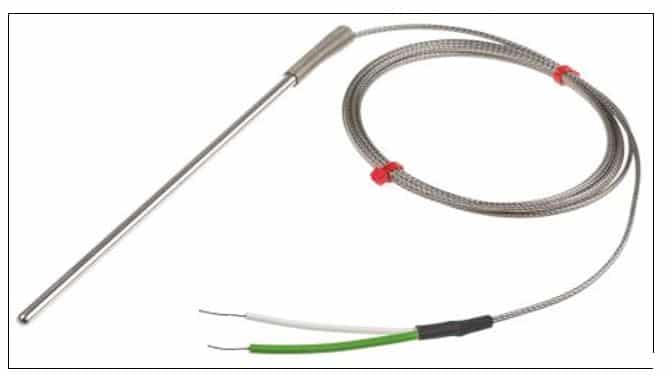
Seebeck effect states that “whenever 2 different metals form 2 junctions, and when these junctions are at different temperatures, the current starts flowing between these junctions and a voltage develops between these junctions”
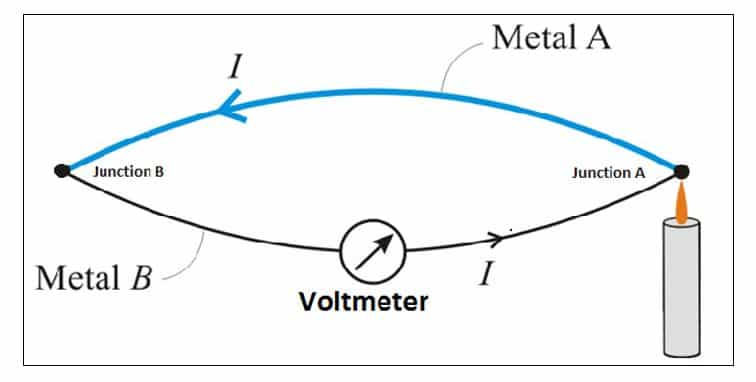
The voltage produced by this is very small i.e. microvolts. The direction of the current is from the hot end to the cold end.
There are 2 other principles related to thermocouples. Let’s discuss them.
- Peltier effect: When an electric current passes through 2 different metals connected at 2 different junctions, a temperature difference between them is observed”. This effect is the reverse of the Seebeck effect.
- Thompson effect: The evolution or absorption of heat when an electric current passes through a circuit composed of a single material that has a temperature difference along its length
The cold junction is should be at 0 ˚C for measurement purposes.
So whenever 2 dissimilar metals form 2 junctions, and both the junctions are at different temperatures, then the current starts flowing from the hot junction to the cold junction and an EMF induces across the open end or at the cold junction. This EMF is proportional to the temperature difference between the 2 junctions.
We call these junctions the hot junction and cold junction. The other names of the hot and cold junction are measuring/sensing junction and reference junction respectively. One term called cold junction compensation is very famous when we talk of thermocouples.
Types of Thermocouples
Here we will discuss different types of thermocouples with their characteristics. The most widely used types of thermocouples are: J, K, E & T. We can classify the thermocouples ;
- On the basis of the types of materials used
- On the basis of types of junctions formed
1. On the Basis of the types of materials used
Let’s see metals used in different thermocouples and also their respective color code. The followings are the types of thermocouples on the basis of types of thermocouple materials.
Type- K Thermocouple
It is the most widely used thermocouple among all types of thermocouples. It has the highest temperature range.
The positive lead of Type K thermocouple approximately has 90% nickel and 10% chromium. The negative lead approximately has 95% nickel, 2% aluminum, 2% manganese, and 1% silicon. The positive yellow cultured lead has the non-magnetic property whereas the negative red cultured lead has the magnetic property.
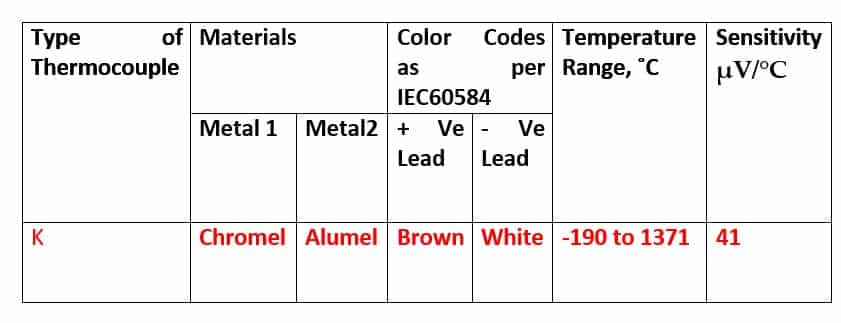
K- type thermocouples can function in the temperature range of -190˚C to +1371˚C. It is cheap and widely used in general-purpose applications where temperature sensitivity requires approximately 41μV/˚C,
The accuracy of type K thermocouples is ±2.2 C% (0.75%).
Type T Thermocouple
We use this thermocouple for the measurement of low temperature. The positive lead is made of copper and the negative lead is made of an alloy of constantan(45% nickel and 55% copper).
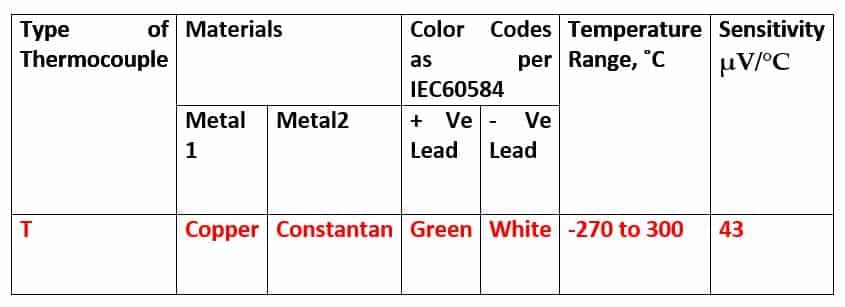
The sensitivity of the type T thermocouple is 43 µV/°C. This thermocouple can work in an oxidizing atmosphere. The T-type thermocouple functions well in the temperature range of this thermocouple are between -270°C to 350°C.
Type J Thermocouple
Type-J thermocouple is cheaper and the most used thermocouple.
The positive white-colored lead is made of iron, and a negative red cultured lead is made of constantan (45% nickel and 55% copper).
The type J thermocouple’s temperature range is between -190˚C to 760˚C. This temperature range and the life span of the J-type thermocouple are less than the K-type thermocouple. However, a J-type thermocouple is most suited for the oxidizing atmospheres.
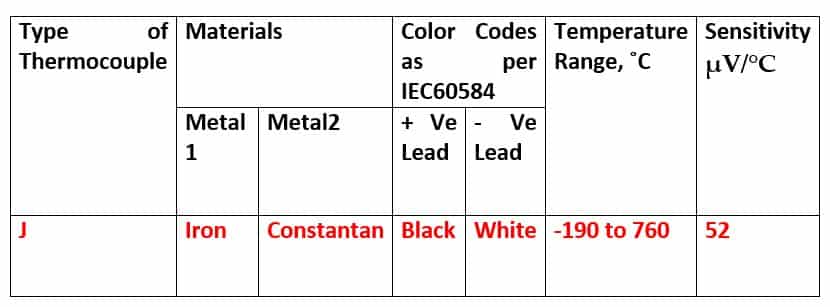
The accuracy of the J-type thermocouples is ±2.2˚C. This type of thermocouple is not suitable for lower-temperature applications. The sensitivity of the thermocouple is approximately 52μV/˚C
Type E Thermocouple
This thermocouple is most suitable for moderate temperatures. At moderate temperature ranges, it has higher accuracy in comparison to type K and J thermocouples. Also, the stability of type-E thermocouples is better than type-K. One very important feature of the type E thermocouple is that it produces the highest EMF per ˚C than other types of thermocouples.
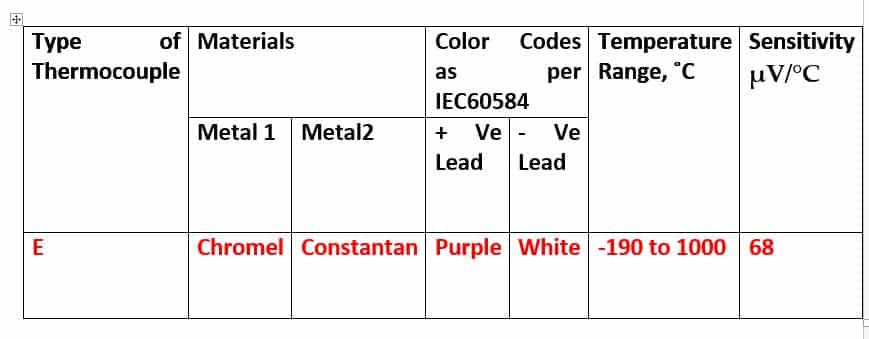
The positive purple-colored lead is made of nickel-chromium (90% nickel and 10% chromium) and a negative red-colored lead is made of constantan (95% nickel, 2% aluminum, 2% manganese, and 1% silicon).
The temperature range of type-E thermocouples is between -190˚C to 1000˚C. , and its standard accuracy is ±1.7˚C. The Type-E thermocouples are most suitable where high accuracy and faster response are required. It is not suitable for vacuum or low oxygen applications and sulphuric environments. It is costlier than the type J and K thermocouples.
Type B Thermocouple
Type B Materials:
- Positive Lead – 70% Platinum and 30% Rhodium
- Negative Lead – 94% Platinum and 6% Rhodium.
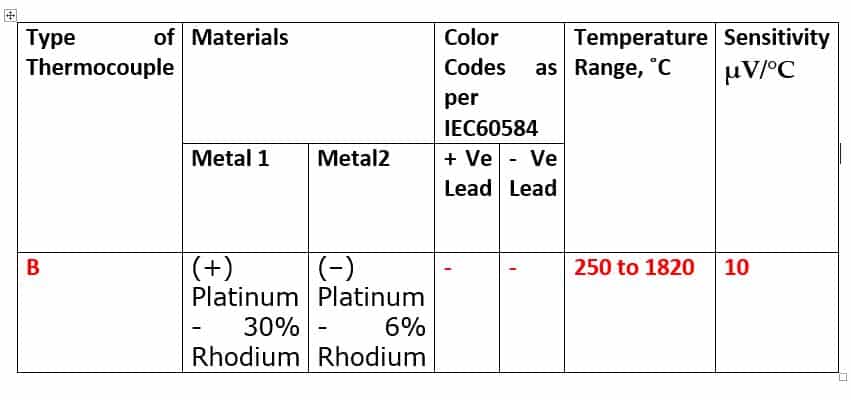
Type B thermocouples can measure the temperature up to 1800°C. However, the sensitivity of this thermocouple is lower in comparison to type R and S thermocouples.
Type N Thermocouple
Type N thermocouple was designed by the Defense Science and Technology Organization (DSTO) of Australia, by Noel A. Burley. The accuracy and temperature range of type N thermocouple is similar to type K thermocouple. The sensitivity of N-type thermocouples is slightly lower than K-type thermocouples.
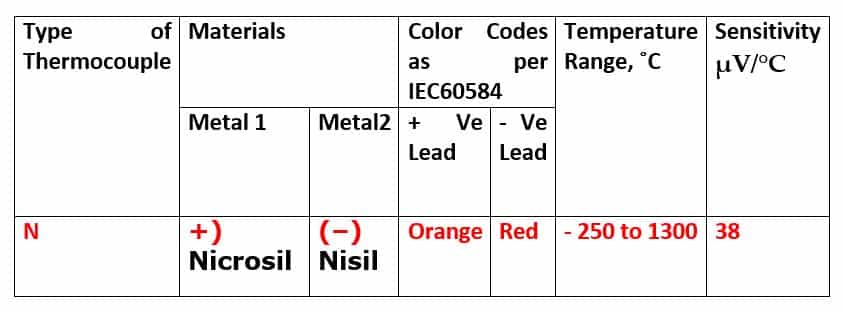
Type N thermocouple has elements of Nicrosil and Nisil. The Nicrosil is a combination of Nickel, Chromium, and Silicon. whereas, the Nisil is a combination of Nickel and Silicon. The N-type thermocouple has the Nicrosil as a positive lead and Nisil as a negative lead.
This thermocouple is the best suitable for use in vacuum, oxidizing atmosphere, inert atmosphere, or dry atmosphere.
Type S Thermocouple
Type S thermocouples are suitable for higher temperature applications. We can use it for lower temperature applications as well because of the high accuracy and stability of Type-S thermocouples. The material composition of positive lead is 90% platinum, 10% Rhodium, and the negative lead has Platinum.

This type of thermocouple is most suitable for those applications where high-temperature measurement needs the highest accuracy. In the Pharmaceutical and Biotech industries, type-S thermocouples are widely used.
Type R Thermocouple
The material composition of Type R thermocouples is almost similar to the type-S thermocouple. However, the output range and stability of the type R thermocouple are slightly more than the type S thermocouple.
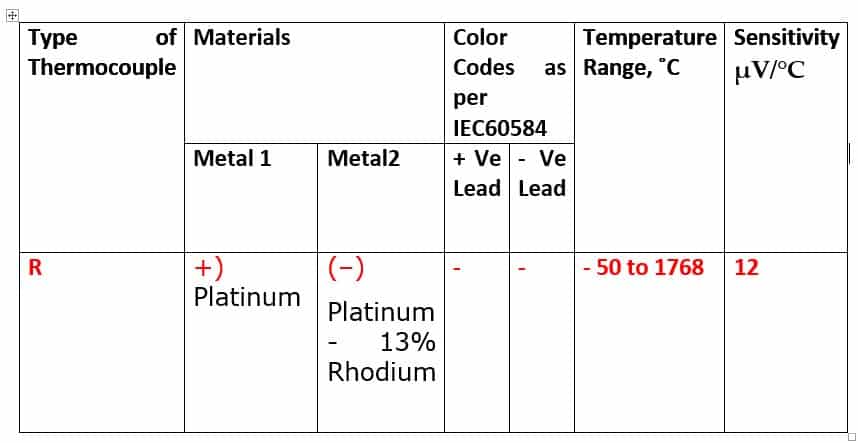
The positive lead of type R thermocouple has 87% Platinum and 13% Rhodium. And the negative lead has Platinum. The temperature range of this thermocouple is between 0 °C to 1600 °C.
2. Types of Thermocouples on the basis of Junction
Now based on types of junctions, there are grounded junction, ungrounded junction, and exposed junction thermocouple. Let’s see them one by one.
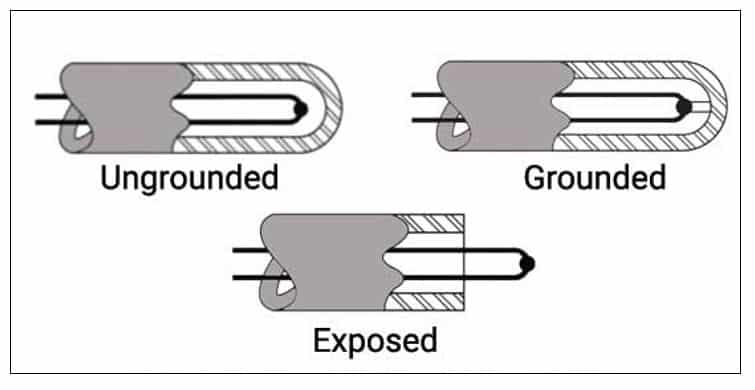
Grounded Junction
From the picture shown above it is clear that in a grounded junction type thermocouple, the thermocouple junction/tip will be physically attached to the probe’s wall making direct contact with it. Because of this direct contact, heat will transfer quickly to the junction/tip of the thermocouple which will make the response of the thermocouple fast. But the drawback of this type of thermocouple junction is that it is susceptible to the noise which is induced by the ground loops.
Ungrounded Junction
In an ungrounded junction type thermocouple, the junction/tip will not be in physical contact with the probe’s wall. Because of this type of structure, heat will not transfer quickly to the junction/tip which will make the response a bit slow. But the advantage of this type of junction is that it is very immune to the noise which is induced by the ground loops
Exposed Junction
In an exposed junction type thermocouple, the junction/tip will be exposed directly to the medium. This leads to a very fast response of the thermocouple. This type of junction can only be used where there is no noise and the system is inert which will not damage the junction/tip.
How to Read the Thermocouple Chart
A thermocouple chart has a temperature vs. millivolt plot. Suppose you want to know the millivolt at 296 ˚C and you have a chart that looks as shown below. Just select your temperature in tens/hundreds/thousand place on Y-axis i.e. 290 and on X-axis select the temperature in units place i.e. 6 and on the junction of both these, your millivolt will be there i.e. millivolt
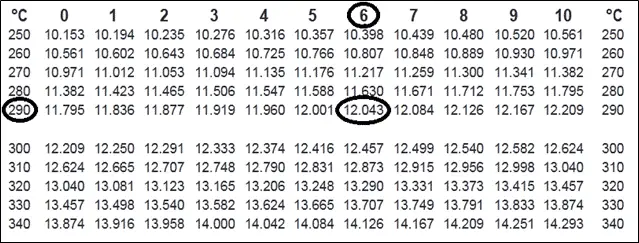
Cold Junction Compensation
The Cold junction compensation is very important for accurate measurement of the temperature. We discussed that the cold junction should be at 0˚C. Now, what if we cannot achieve ˚C?
Suppose our reference junction is at 25 ˚C, but it should be at 0 ˚C. So simply add millivolts corresponding to 25 ˚C which will compensate it to 0 ˚C. This is known as cold junction compensation.
Compensation & Extension Leads
Thermocouples are sometimes used with extension or compensation leads. Now what are compensation and extension lead and why do we need them?
Assume that a temperature transmitter is situated at a distance position where our thermocouple leads won’t reach, but we need to connect it to the temperature transmitter anyhow.
Now let’s use some cable and connect it between the thermocouple and temperature transmitter. Will it work? What will be the issue?
Yes, you are right!
Again more junctions will be formed and some voltage will be generated there also and we won’t get the exact temperature.
Compensation leads: metal with the same properties as metal of thermocouple
Extension leads : The same type of metals as used in thermocouples.
Unique properties for different thermocouples
Let’s see some unique properties for different thermocouples
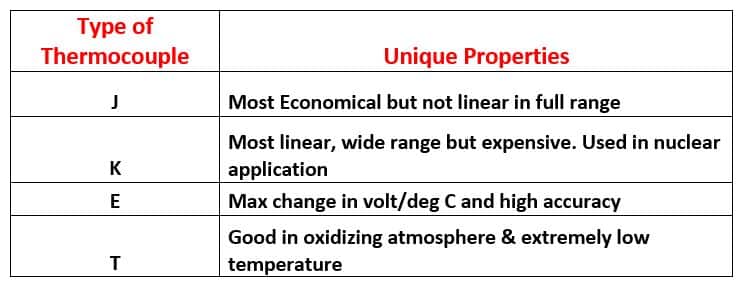
Thermocouple Applications
Now let’s see the practical applications of thermocouples. It generates microvolts and gives them to a temperature transmitter which converts the microvolts signal to a signal which is sent to PLC/DCS/ESD system for further processing. The followings are the applications of various types of thermocouples.
- It is used to measure the temperature in the steel and iron industries. For, this type of application, type B, S, R, and K thermocouples are used in the electric arc furnace.
- We use the principle of a thermocouple to measure the intensity of incident radiation. The instrument is called a thermopile radiation sensor.
- Thermocouples are used as a temperature sensor in thermostats to measure the temperature of the office, showrooms, and homes.
- The thermocouple is used to measure the temperature of the pilot flame, like in a water heater.
- The thermocouples are used in all types of process industries like cement, steel, fertilizer, pharmaceuticals, etc.
Read Next: